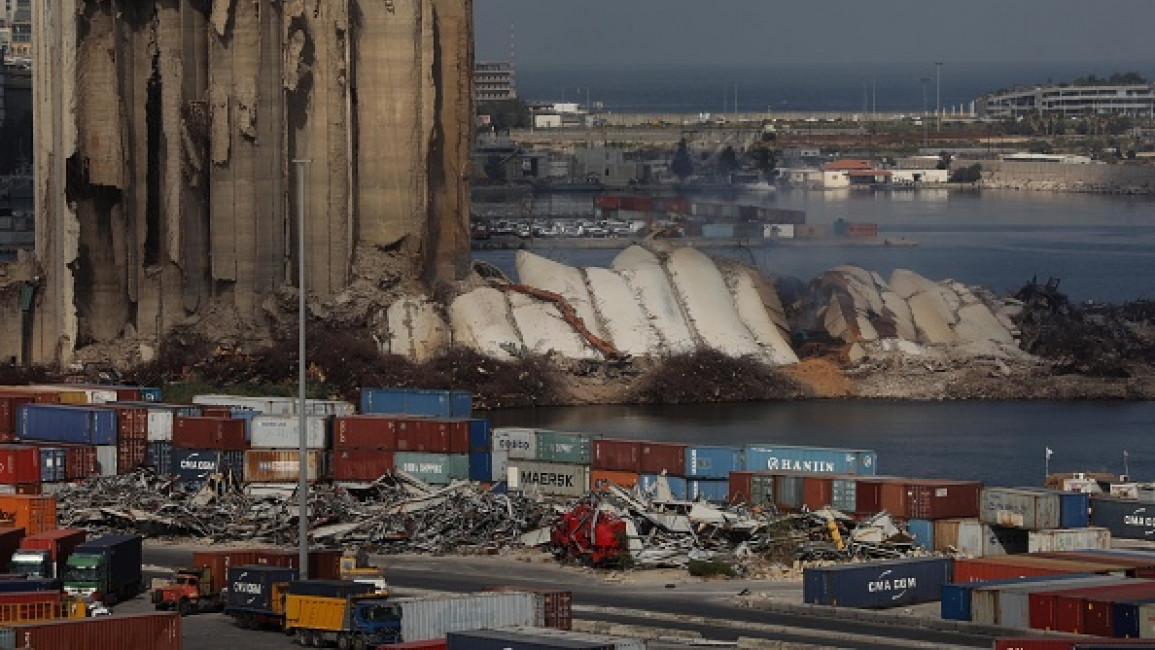Beirut civil society urges remaining port silos to be turned into memorial
The northern section of Beirut's port grain silos collapsed on Tuesday morning, two years after the 4 August Beirut port explosion which killed at least 253 people and wounded 7,500.
Eight silos collapsed more than a month after a fire erupted from fermenting grains which had sat at the feet of the silos since the port explosion. Previously, portions of the silos had collapsed on 31 July and 4 August due to the fire.
The southern portion of the structure is still stable, Emanual Durand a French engineer who monitors the silos via sensors told mainstream media on Tuesday.
The collapse of the government silos angered those who wanted to preserve the silos as a monument to the Beirut port explosion and a symbol of the government's failure to deal with the case.
"The silos represent the loss of justice for the inhabitants who were directly affected by the explosion. They're a reminder of that moment where they lost their beloved or their families," Alia Fares, a heritage expert with Landward Heritage Research, told The New Arab.
Lebanon's Prime Ministry sent a letter on Tuesday to the Minister of Public Works and Transport asking him to "maintain and preserve" the southern silos as a "historical monument in memory of the port's martyrs."
Civil society groups welcomed the move but said it did not go far enough.
"We call on the Prime Minister and the ministers to take an official decision to preserve the southern ruins and amend the previous demolition decision. Enough procrastination and distraction," a civil society movement called "The Silent Witness" said in a statement on Tuesday.
The victims' families of the Beirut Port Explosion have said that there should be no reconstruction of the Beirut port and the silos until justice was achieved for the victims.
No one has been charged in connection with the port blast two years on and the domestic investigation has been stalled since December 2021.
Despite this, parliament revealed plans to demolish the silos in April to clear the way for the area's reconstruction. The plans sparked anger, with civil society movements like "The Silent Witness" mobilising against the structure's destruction.
"A lot could have been done by the government to make up for the loss [of the port blast], at least by protecting and preserving the silos. The fact that the government is not listening to anyone is a sign of how much the country is longing for a serious governmental change," Fares said.
Plans for demolition have halted since, although the Ministry of Public Works announced last week that it reserved 25,000 square meters in the port for new silo construction.
According to architects, demolishing then building new silos would likely be more expensive than simply refurbishing existing structures.
Much of the silos' structure had remained intact despite absorbing the blast's shockwave. Half of the structure is underground and would require excavation and removal before building a new structure on the site.
"Many alternative architectural plans to reconstruct the port and refurbish the grain silos were presented by several local and international architects and engineers," Gioia Sawaya, an architect interested in the link between memory and urbanism, told The New Arab.
Sawaya came up with a design of her own after a site visit to the silos in July 2021. She noticed that the soles of her boots began to melt when walking on the fermenting grain and recognised the danger the discarded wheat posed.
Her proposal used the grain as a form of "grain-based bio-composite material" to construct a "place of remembrance for a community touched by tragedy." In doing so, the wheat would have been cleaned up from the basin of the silos and prevented from fermenting and catching alight.
Still, despite the collapse of the northern silo which "totally could have been avoided if the authorities had taken proper action," there is still the possibility of preserving the remainder of the structure.
"What is next to be done is quite straightforward: The southern section must be fought for, protected and safeguarded. While no longer being a carrier of the nation's grain, [the silo] is a very strong carrier of meaning," Sawaya said.




